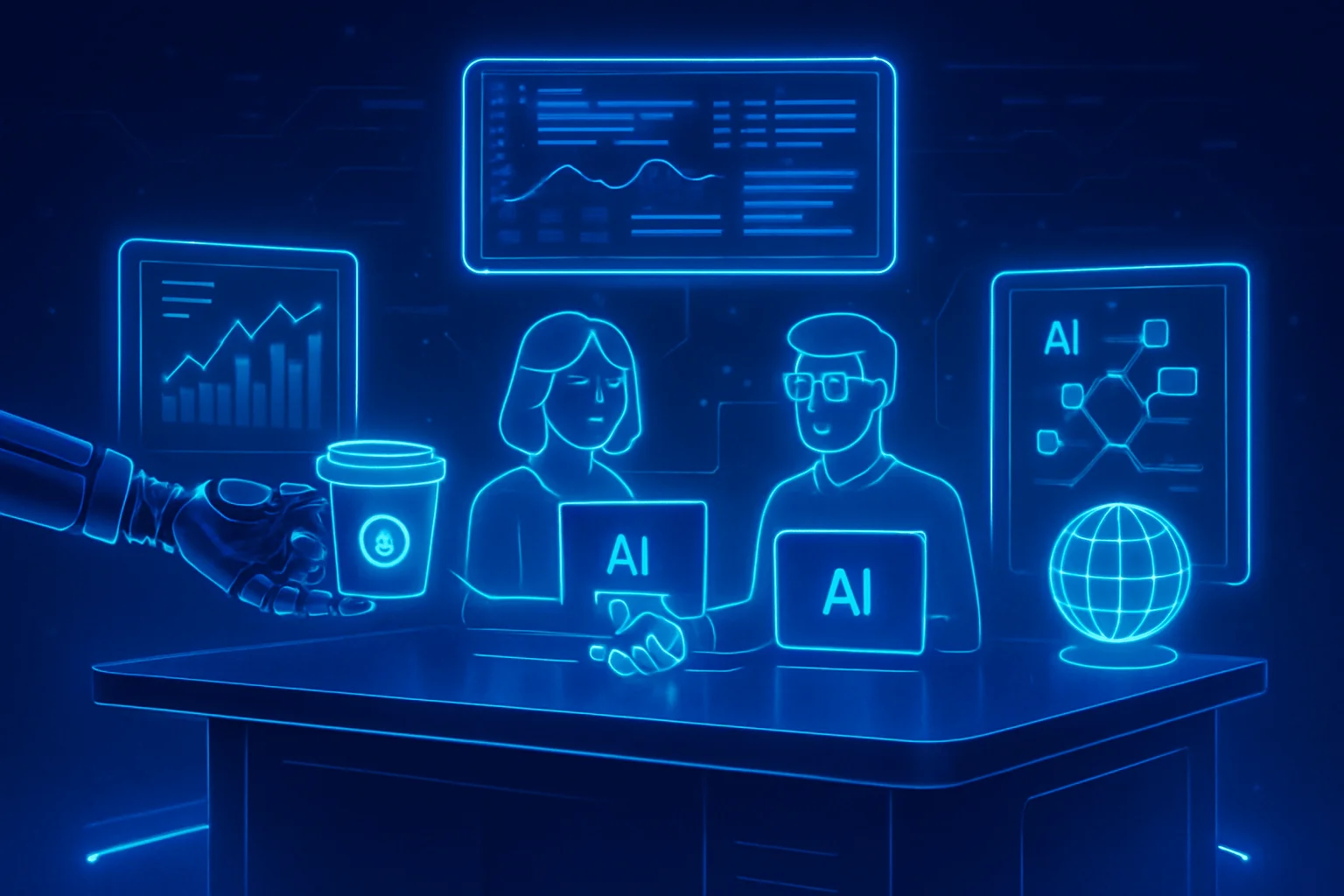How AI Workflow Automation Revolutionizes Business Productivity

Imagine walking into your office on a Monday morning to find that your emails have been organized, reports generated, customer inquiries answered, and even your next meeting scheduled—all before you’ve brewed your first cup of coffee. This isn’t science fiction; it’s the new reality powered by advances in AI workflow automation. As organizations battle relentless workloads and mounting expectations for speed, the ability to streamline operations is no longer just an advantage—it’s a necessity for staying competitive. AI-driven automation is rapidly transforming the way businesses approach everything from data entry to customer engagement, unlocking efficiencies that were previously unattainable. In this article, we’ll explore how cutting-edge tools are intelligently handling repetitive tasks, enhancing decision-making, and enabling teams to focus on more strategic work. Through real-world use cases drawn from a range of industries, you’ll discover practical strategies to implement in your own operations—boosting productivity and driving measurable results where it matters most.
AI-Driven Document Processing & Data Extraction
Modern businesses are inundated with paperwork: contracts, invoices, intake forms, and more. Manual processing is time-consuming, subject to human error, and slows down operations. AI-powered document automation platforms now intelligently classify, extract, and validate information with minimal human oversight. By using Natural Language Processing (NLP) and Optical Character Recognition (OCR), these systems ingest documents—scanned or digital—then transform unstructured content into organized, actionable data, seamlessly routing it to downstream applications like ERPs, CRMs, or compliance databases.
Benefits:
- Reduces manual data entry labor by up to 80%
- Accelerates turnaround times for internal and customer-facing processes
- Lowers error rates and minimizes compliance risk
- Enhances tracking and traceability of business documentation
- Enables touchless workflows in finance, legal, and HR operations
“Automating document workflows is more than just digitization; it means actionable intelligence is now available in real time, increasing business agility.” – Dr. Rachel Lin, Workflow Digitization Expert
Real-World Scenario:
A global logistics company handles thousands of bills of lading, delivery receipts, and customs documents weekly. By integrating AI document processing, they reduce validation and entry times from 5 days to a few hours, freeing Ops teams to focus on exceptions and strategic work rather than chasing paperwork piles.
Intelligent Email Triage and Response
Corporate inboxes are deluged with high volumes of client requests, support tickets, internal inquiries, and routine memos. AI-driven email triage systems classify, prioritize, and route emails to the right recipient, flag urgent issues, and auto-draft initial responses based on content analysis. Machine learning models continuously adapt to context, understanding tone, intent, and subject matter to prevent bottlenecks and streamline communication.
Benefits:
- Shortens response times and ensures urgent issues are rapidly addressed
- Frees up knowledge workers for high-value activities by automating repetitive responses
- Reduces email fatigue and improves workforce engagement
- Maintains consistent brand voice and compliance with automated templates
- Increases customer satisfaction by eliminating delays
“Smart inbox automation creates an ‘always-on’ team capable of responding at digital speed, transforming customer and partner relationships for the better.” – Samuel Chu, CTO at EngageAI
Real-World Scenario:
A midsize law firm receives hundreds of client emails daily, ranging from discovery requests to deadline follow-ups. AI email triage reads, tags, and routes each message to the relevant attorney or paralegal, automatically replying to standard queries and flagging critical court filings, resulting in zero missed deadlines and happier clients.
AI-Powered Predictive Maintenance Scheduling
Manufacturers, utilities, and logistics businesses depend on the health of their machinery and fleets. Traditional maintenance is often reactive, based on fixed schedules or after breakdowns occur, which leads to costly downtime and excess inventory. AI-based predictive maintenance systems ingest real-time sensor data, historical logs, and even environmental factors to forecast potential equipment failures. Proactive scheduling and parts ordering minimize disruption and optimize use of assets.
Benefits:
- Reduces unplanned downtime and associated production losses
- Lowers maintenance costs by replacing only worn components as needed
- Optimizes parts inventory and procurement cycles
- Increases equipment lifespan and ROI through timely interventions
- Enhances workforce allocation by automating scheduling and reporting
“With predictive maintenance, the question shifts from ‘when will machines break?’ to ‘how do we prevent downtime altogether?’ That’s the real operational leap forward.” – Nia Patel, Industrial AI Consultant
Real-World Scenario:
An aerospace parts manufacturer leverages AI to monitor vibrations, temperature, and pressure data from CNC machines. The system predicts potential spindle failures a week in advance, scheduling repairs during off-hours and averting costly production halts that previously cost up to $250,000 per incident.
Automated Talent Sourcing & Screening
Finding and qualifying top talent is a perennial challenge for HR departments. Traditional resume screening is inefficient and susceptible to unconscious bias. AI recruiting platforms evaluate thousands of profiles in minutes, cross-referencing job requirements, experience, and skills with public data, portfolios, and online interactions. AI-driven chatbots can engage candidates, conduct initial screenings, and schedule interviews, ensuring recruiters spend more time on candidate experience and strategic workforce planning.
Benefits:
- Speeds up time-to-hire and reduces recruitment costs
- Identifies high-potential candidates who may be overlooked by manual review
- Scales talent sourcing during high-growth periods or hiring surges
- Minimizes bias through data-driven, criteria-focused evaluations
- Improves candidate engagement with timely, automated communications
“Smart talent workflows turn recruitment into a seamless, data-enriched process—freeing HR to focus on culture and retention, not paperwork.” – Angela Yeo, HR Technology Specialist
Real-World Scenario:
A tech startup facing rapid growth deploys AI sourcing to analyze developer communities, GitHub contributions, and resumes. The platform filters candidates for specialized Python skills, instantly surfaces those with proven open-source credentials, and schedules screening calls—doubling qualified applicant throughput in one month.
FAQs
Q1: How secure is sensitive data when processed by AI workflow automation systems, especially for compliance-heavy industries?
A1: Modern AI workflow solutions are architected with enterprise-grade security, implementing data encryption (both at rest and in transit), access controls, and audit logs. Vendors serving compliance-heavy sectors (like finance or healthcare) often pursue SOC 2, HIPAA, or GDPR certification. Integrations with existing security frameworks, frequent third-party audits, and customizable data retention policies further minimize risk. Always choose platforms with transparent compliance documentation and offer on-premises or private cloud deployment options if sensitive data residency is required.
Q2: How quickly can organizations expect ROI after implementing AI automation in their workflows?
A2: ROI timelines depend on process complexity, workflow volume, and integration with existing systems. Many organizations report cost and efficiency gains within three to six months of deployment, especially in high-throughput areas like document intake or helpdesk triage. Measurable benefits include reduced cycle times, lower error rates, and labor cost savings. Scaling automation across additional departments and leveraging AI analytics for decision support compound returns over the first year.
Q3: What skills or training should current employees have to work alongside AI-driven automation tools?
A3: AI workflow automation doesn’t eliminate human roles; it augments them. Employees benefit from digital literacy, data-driven decision-making abilities, and a growth mindset. Upskilling programs may cover basic understanding of AI concepts, data privacy best practices, and how to interpret AI-generated insights. Familiarity with workflow management tools, troubleshooting alerts, and collaborating with IT or data teams ensures seamless handoffs between human judgment and automated agents.
Key Takeaways
- AI workflow automation adapts to existing business systems, often integrating seamlessly without a total process overhaul.
- Real-time analytics from automated workflows enable proactive adjustments and continuous process improvement.
- Customizable AI models can be adapted to specific industry jargon, structured data formats, and regulatory needs.
- User-friendly dashboards empower non-technical staff to monitor and audit AI-driven processes, promoting transparency and trust.
- Automated systems generate process logs and exception reports, streamlining compliance audits and reducing risk exposure.
- Beyond routine tasks, AI enhances business continuity by ensuring critical workflows proceed uninterrupted in dynamic environments.
- Scaling AI automation across departments drives synergy, unlocking new efficiencies as connected tasks are optimized in concert.
Embracing AI workflow automation isn’t just about staying competitive—it’s about liberating your team from manual bottlenecks and unlocking true operational efficiency. As we’ve seen through concrete use cases and actionable strategies, the path to transformative productivity is within reach for businesses ready to adopt smart automation. Now is the moment to reflect on your own workflows: where could AI bring the most value? Whether you’re just starting or refining your approach, committing to this evolution can set your organization apart. Dive deeper, share your experiences or questions below, and subscribe for insights that will help you turn potential into performance—let’s shape the future of work together.



